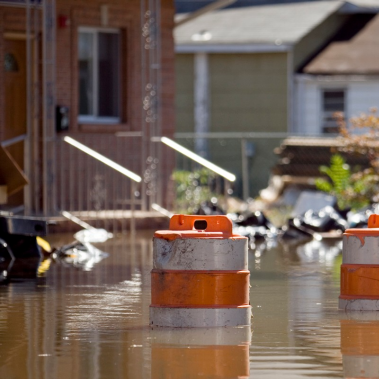This perspective is the results of a collaboration of experts from Marsh McLennan, Marsh, Guy Carpenter, and Blue Marble, an Impact Insurtech with a mission to enable insurance solutions for underserved communities and help reduce the protection gap. By bringing together key partners and stakeholders to incept successful programs, Blue Marble acts as project and stakeholder manager and leverages their own proprietary digital platform to design and model climate/weather-related parametric solutions. Blue Marble arranges risk transfer, including insurance and reinsurance, through its owner companies, among which Marsh McLennan.
Nature-related risks are already material, harming communities, impacting business assets and operations, supply chains, and affecting lending and insurance portfolios. Environmental degradation and climate change exacerbate each other, and their compounding effects are set to escalate over time. Continued developments in the parametric insurance space are creating new avenues for managing these risks. When utilized at scale, parametric solutions can enable rapid payouts based on transparent criteria, allowing households and businesses to financially recover within hours of an extreme weather event. The applications extend beyond direct losses from physical risks to a whole range of complex and interdependent challenges including environmental degradation, and community resilience.
The innovation in parametric solutions is driven by technological advances and the pressures of growing protection gaps.
Data proliferation, remote sensing technologies, and innovations in analytics and modeling mean that it is now possible to design a range of tailored parametric insurance products addressing a wider spectrum of climate risks. This has become particularly relevant in the face of growing protection gaps, where traditional insurance coverage is either absent or facing challenges due to the increasing risks.
This is already evident in the case of flooding: According to Marsh McLennan estimates, 18% of the global population is currently threatened by flooding, and even limiting global warming to 2 °C would cause this percentage to double. Similarly, the impacts of flooding on infrastructure are already material and set to grow over time, with power plants and international ports and airports under increasing strain. Recent flood disasters have revealed significant shortcomings in risk management practices in both high- and low-income countries. This has emphasized the inadequacy of existing resilience methods to handle present-day risks, let alone deal with the rapidly rising levels of threat. This is also evident in the significant protection gap for flooding, particularly in lower-income communities. These tend to be more exposed to flood risk and more vulnerable, as many households and businesses simply do not have adequate coverage for repairs and rebuilding.
New technologies are enabling re/insurers to more accurately identify and price triggers for the risks being insured. The affordability of parametric products can hence prove especially valuable in closing protection gaps among communities with low access to financial capital, and for those that face increasingly unaffordable premiums for traditional risk transfer solutions.
Innovative approaches demonstrate the growing role of parametric insurance in supporting socioeconomic development.
Parametric solutions are being applied to an increasingly broader range of contexts, providing coverage for low-income communities, and coverage for previously uninsurable risks like the impact of extreme heat on labor productivity. These have yielded beneficial spillover effects for supporting socioeconomic development in vulnerable areas where traditional insurance markets have lacked the capacity or willingness to provide coverage.
Expanding flood coverage to low-income communities in New York City. Marsh McLennan’s community-based catastrophe insurance (CBCI) pilot in New York City uses parametric triggers to provide flood coverage to lower income residents. Under the model, homeowners benefit from a CBCI program for all or a portion of a stated climate peril by a group insurance policy, typically purchased by a local government agency or community organization. The community-based underwriting approach reduces administrative, risk financing and distribution costs, opening up both risk reduction and risk transfer options for a large group of homeowners.
Addressing supply chain risk and supporting smallholder farmers. A collaboration between Blue Marble and Nespresso provides rainfall-indexed parametric drought cover to more than 13,000 smallholder coffee farmers in Colombia, Indonesia, Kenya and Zimbabwe. Incepted in 2018, the project has already paid out a total of $4.5 million, enabling farmers to have quick access to monetary resources and rapidly recover from increasingly severe drought risks. More resilient coffee production has also enabled the coffee company to mitigate their own supply chain risks. Following the success of this program, Blue Marble was recently appointed to pilot solutions for coffee farmers within Nescafe’s supply chain.
In an ongoing partnership with the World Food Program in the context of the R4 Rural Resilience Initiative, Blue Marble provides parametric cover to smallholder farmers in Zimbabwe and Mozambique to address food and income insecurity caused by climate change. Blue Marble designed a weather index and provided a low-cost digital insurance platform for program administration. About 9,500 households and 36,000 individuals—62% the beneficiaries being women—have so far benefited from the partnership.
Reducing lost income. Blue Marble has recently announced a new partnership with India’s Self Employed Women's Association (SEWA) and Arsht-Rock to address the life-threatening impacts of extreme heat on women workers in the informal sector in India. The Extreme Heat Income Insurance tool blends tech-enabled heat risk awareness and mitigation techniques with a parametric insurance program that covers loss of income during heatwaves. The initial pilot is targeting 21,000 SEWA members in Ahmedabad across various occupations including salt pan miners, waste recyclers, and street vendors. The goal is to scale the project to the entire 2.5 million SEWA member community across 18 states.
Parametric solutions can help address other drivers of climate change, including environmental degradation.
As highlighted by the 2023 Global Risks Report, environmental degradation and climate change exacerbate each other, leading to a cascade of negative impacts for businesses and society – such as increased unemployment, capital flight, political instability, and large-scale economic migration. In particular, environmental degradation can undermine investments in climate mitigation and adaptation, such as nature-based solutions.
According to Marsh McLennan’s Embracing Nature report, preserving and restoring ecosystems helps to mitigate climate risks while unlocking a broad range of socioeconomic co-benefits. Natural features such as forests, mangroves, and coral reefs can play a significant role in limiting the impacts of climate extremes while serving as tools in the fight against rising carbon emissions. Reforestation, for instance, can contain the threats of flooding and heatwaves; wetlands in the East Coast of the United States, reduced the economic losses caused by Superstorm Sandy in 2013 by more than half a billion dollars. A recent study from Guy Carpenter also demonstrated how nature-based solutions can reduce wildfire insurance premiums. The placement of a fire buffer—an area of reduced fire fuel that could include areas such as green space or community parklands—along one corridor in Paradise, US could significantly reduce average annual losses and be as effective at reducing fire risk as the enforcement of updated fire resilient building codes. While urbanization has been one of the key drivers of environmental degradation, an analysis of CDP’s 2022 Cities Adaptation Actions database reveals that cities are starting to adopt a nature-positive paradigm to build climate resilience.
Parametric insurance solutions have already shown potential in reducing nature-related risks and are expected to draw increasing attention as the impacts of environmental degradation on businesses and society become more apparent. Parametric products can be tied to the abundance of a natural resources, or the presence of harmful nature-related elements; several of these solutions have already been used to compensate for poor crop yields due to pests, diseases, and groundwater quality. Parametric solutions can also be complementary to established insurance solutions, such as environmental liability and business interruption, to offer businesses greater risk coverage.
There is already a large amount of data and analytics available to assess nature-related risks. These include satellite imagery to monitor environmental degradation and tools that model supply-chain risks based on ecosystem service disruption. The growing understanding of the role of nature in regulating climate will likely play a critical role in driving further developments in parametric insurance.
Supportive regulatory frameworks and integration with wider resilience strategies are important enablers for further innovation.
The administrative efficiencies of parametric structures have opened up the door to an entirely new set of valuable climate risk discussions, protecting a greater number of vulnerable communities, and bolstering climate resilience efforts. Despite the benefits of parametric solutions, their uptake has been hampered by disincentives embedded in existing regulatory statutes. These must be addressed to foster innovations in risk transfer solutions and encourage adoption by businesses and communities.
The use of parametric solutions must be combined with broader resilience strategies designed in coordination with governments and regulators. Public-private partnerships can create the conditions for a functioning private insurance market by providing new capital frameworks for re/insurers to improve their financial resilience and expand coverage through innovative solutions like public-private risk pools.
Insurance needs to be paired with risk reduction measures such as hazard mitigation, building codes, and community resilience planning. Projects like Marsh McLennan’s New York City CBCI pilot project demonstrate the value of combining risk reduction and risk transfer measures to build greater climate resilience.



